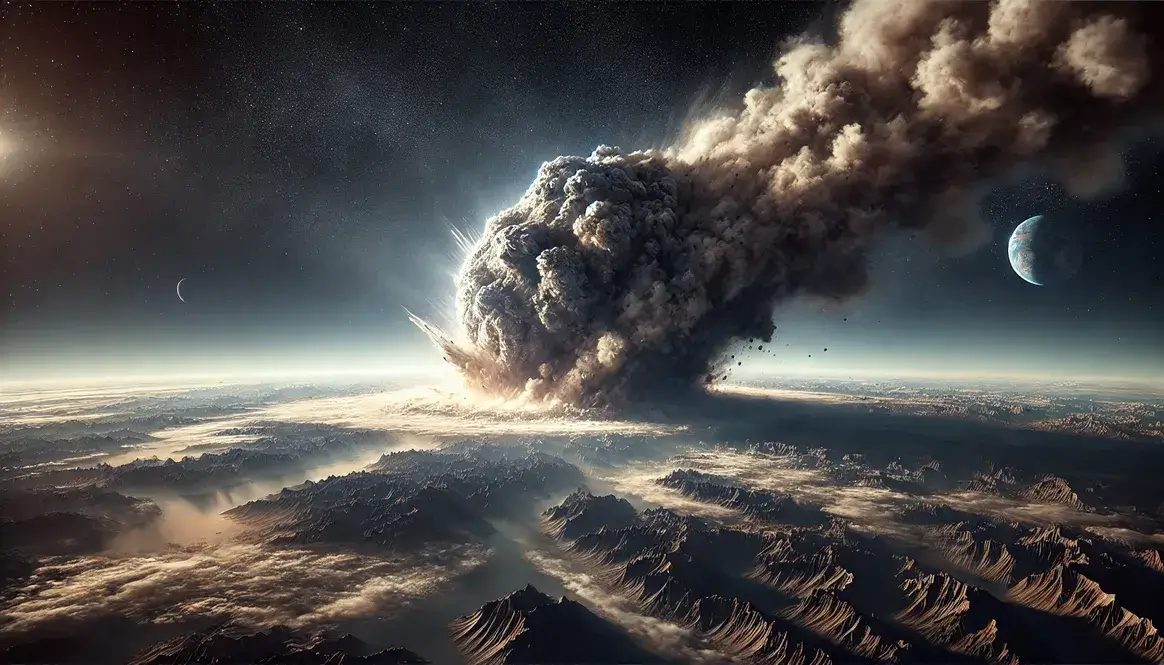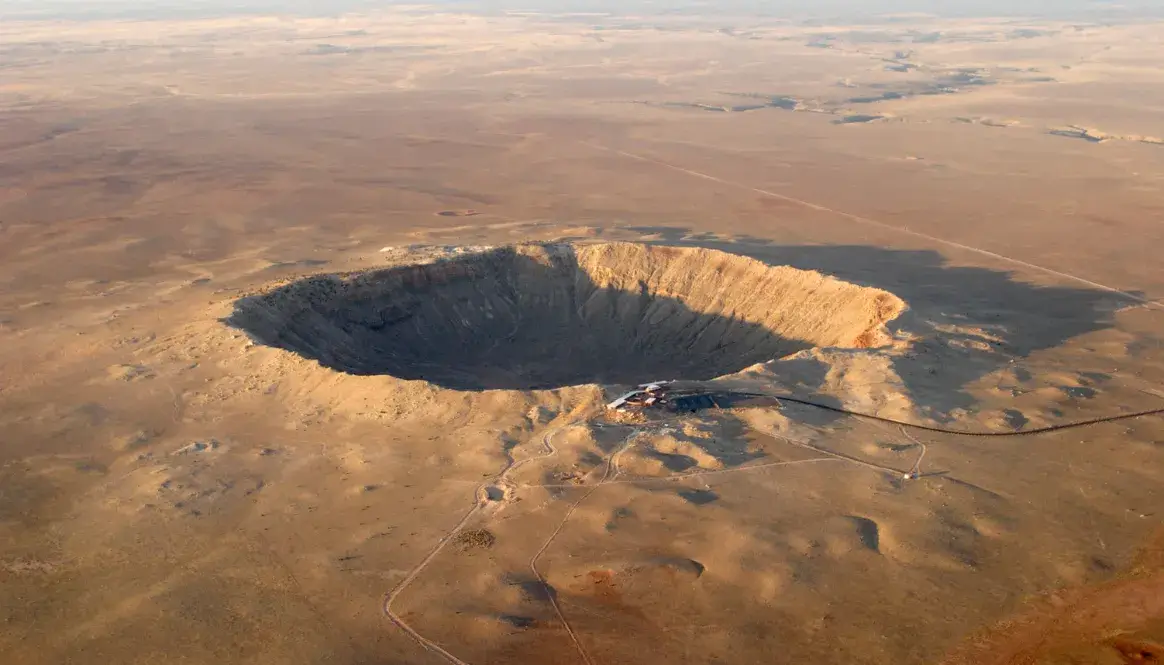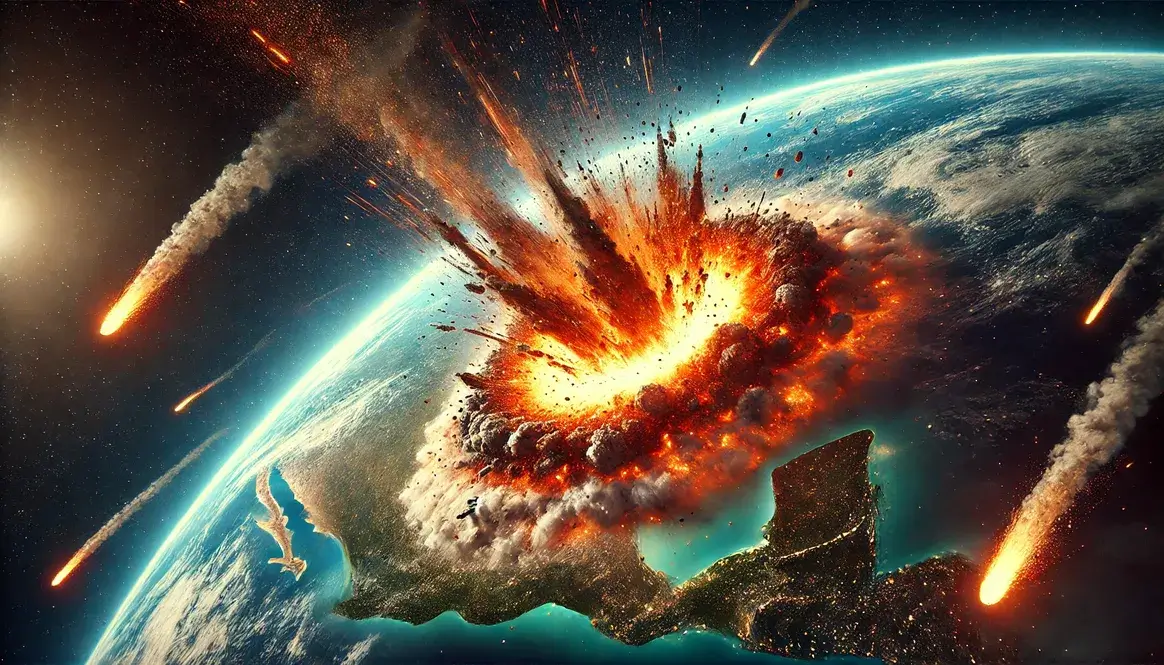About 66 million years ago, Earth experienced a catastrophic event that would forever change the course of life on our planet. A massive asteroid, roughly 10 kilometers in diameter, slammed into the Yucatan Peninsula, creating what we now know as the Chicxulub crater.
This cosmic collision wasn’t just a localized disaster – it triggered a chain of events that led to widespread environmental changes, including severe air pollution. The force of the impact was so intense that it vaporized rock and sent massive amounts of debris into the atmosphere, creating a toxic cocktail that would blanket the Earth for years to come.
K-Pg extinction air pollution: A toxic cocktail
The K-Pg extinction air pollution was unlike anything our planet had experienced before. It wasn’t just one type of pollutant, but a mix of several harmful substances that filled the air, each contributing to the devastating effects on life during this period.
Dust and debris
When the asteroid hit, it didn’t just create a big hole in the ground. The impact was so powerful that it pulverized rock and sent it flying high into the atmosphere. This wasn’t your everyday dust – it was a mix of various materials that had been part of the Earth’s crust and the asteroid itself.
Composition of ejected material:
- Pulverized rock from Earth’s crust
- Vaporized asteroid material
- Soot from widespread fires
The dust and debris thrown into the air were incredibly fine particles, small enough to stay airborne for extended periods. This fine dust acted like a blanket, blocking out sunlight and causing significant cooling of the Earth’s surface.
Global distribution of dust:
The impact was so powerful that it didn’t just affect the area around the crash site. The dust and debris were thrown high into the atmosphere, where strong air currents carried them around the globe. Within hours, the sky began to darken worldwide, and within days, a thick layer of dust encircled the entire planet.
| Time after impact | Dust distribution |
|---|---|
| Hours | Regional darkening |
| Days | Global dust layer forms |
| Weeks | Maximum darkness period |
| Months | Gradual settling begins |
This global distribution of dust and debris was a key factor in the widespread effects of the K-Pg extinction event. No corner of the Earth was left untouched by this choking cloud of destruction, setting the stage for one of the most significant mass extinctions in our planet’s history.
Sulfur compounds
The K-Pg extinction air pollution wasn’t just about dust and debris. One of the most harmful components was the release of sulfur compounds, which played a crucial role in the long-term environmental changes.
When the asteroid struck, it hit an area rich in sulfur-containing rocks. The extreme heat from the impact vaporized these rocks, releasing massive amounts of sulfur into the atmosphere. This sudden influx of sulfur had far-reaching consequences:
- Sulfur dioxide formation: The released sulfur quickly combined with oxygen in the air to form sulfur dioxide (SO2).
- Atmospheric reactions: In the presence of water vapor, SO2 underwent further reactions.
- Sulfuric acid aerosols: These reactions led to the formation of tiny droplets of sulfuric acid suspended in the air.
The sulfuric acid aerosols were particularly problematic. They formed a hazy layer in the upper atmosphere, further blocking sunlight and contributing to global cooling. But that’s not all – these aerosols also led to acid rain, which had devastating effects on terrestrial and aquatic ecosystems.
Carbon dioxide and other greenhouse gases
While sulfur compounds were cooling the planet in the short term, the impact also released large amounts of greenhouse gases, setting the stage for long-term climate changes.
The primary source of CO2 release was the vaporization of carbonate rocks at the impact site. When these rocks were suddenly heated to extreme temperatures, they released their stored carbon in the form of CO2. But that wasn’t the only source:
| Source | Contribution to CO2 release |
|---|---|
| Vaporized carbonate rocks | Major – immediate release |
| Widespread fires | Significant – ongoing for weeks or months |
| Decaying organisms | Gradual – continuing for years |
In addition to CO2, other greenhouse gases were also produced. Methane, a potent greenhouse gas, was released from disturbed wetlands and permafrost regions. The impact may have also triggered the release of methane hydrates from the ocean floor, further contributing to the greenhouse effect.
These greenhouse gases would play a crucial role in the climate swings following the impact. After the initial cooling period caused by the dust and sulfur aerosols, the accumulated greenhouse gases led to a period of rapid warming. This stark contrast in climate conditions posed additional challenges for the surviving species, making adaptation even more difficult in the post-impact world.
The Spread and Duration of Air Pollution
The K-Pg extinction air pollution wasn’t a localized event – it was a global catastrophe that engulfed the entire planet. The spread of pollutants was rapid and far-reaching, thanks to the Earth’s atmospheric circulation patterns.
Global extent of pollution
Within hours of the impact, the first signs of pollution began to appear in the skies near the Chicxulub crater site. But it didn’t stop there. The immense energy of the impact propelled pollutants high into the atmosphere, where they were caught by powerful air currents.
- Stratospheric injection: The force of the impact sent pollutants into the stratosphere, above the level where rain could wash them out.
- Jet streams: High-altitude winds rapidly distributed the pollutants around the globe.
- Global coverage: Within days to weeks, the entire planet was enveloped in a toxic haze.
This global spread meant that no ecosystem was spared from the effects of the pollution. From the poles to the equator, life on Earth faced unprecedented challenges.
Timeframe of different pollutants in the atmosphere
The duration of the pollution varied depending on the type of pollutant. Some cleared relatively quickly, while others lingered for years, shaping the post-impact world.
| Pollutant | Duration in atmosphere | Effects |
|---|---|---|
| Dust and debris | Months to a few years | Initial darkness and cooling |
| Sulfur aerosols | 1-2 years | Prolonged cooling, acid rain |
| CO2 and other greenhouse gases | Decades to centuries | Long-term warming |
The immediate aftermath was dominated by the dust and debris. For weeks to months, the skies remained dark, causing what scientists call an “impact winter”. This period of darkness and cold was particularly devastating for plant life, forming the base of most food chains.
As the dust began to settle, the sulfur aerosols took center stage. These tiny particles remained suspended in the upper atmosphere for 1-2 years, continuing to block sunlight and cool the planet. The acid rain caused by these aerosols further stressed already struggling ecosystems.
Lastly, the increased levels of CO2 and other greenhouse gases persisted the longest. While their warming effects were initially masked by the cooling from dust and sulfur, they eventually led to a period of rapid warming. This long-term climate change posed additional challenges for species trying to recover from the initial catastrophe.
The varying timescales of these pollutants created a complex and ever-changing environment. Life forms that managed to survive the initial impact then had to contend with a series of different environmental challenges, each driven by a different aspect of the air pollution.
Climate Effects of K-Pg Air Pollution
The air pollution resulting from the K-Pg extinction event had profound effects on Earth’s climate, causing dramatic swings in temperature and weather patterns. These climate changes occurred in two distinct phases: an initial cooling period followed by a prolonged warming phase.
Initial cooling phase
The first climate shift experienced after the impact was a severe cooling period, often referred to as an “impact winter.” This cooling was primarily caused by the massive amounts of dust and aerosols thrown into the atmosphere by the asteroid collision.
Impact winter caused by dust and aerosols:
- Sunlight blockage: The thick layer of dust and sulfur aerosols in the upper atmosphere acted like a giant sunshade, preventing much of the sun’s energy from reaching Earth’s surface.
- Albedo effect: The dust particles increased Earth’s albedo (reflectivity), bouncing more sunlight back into space.
- Photosynthesis disruption: With less sunlight reaching the surface, plant life struggled to photosynthesize, leading to a collapse of food chains from the bottom up.
Duration and severity of cooling:
The impact winter was intense but relatively short-lived compared to the entire extinction event. Scientific estimates suggest that the most severe cooling lasted for several years to a few decades.
- Temperature drop: Global average temperatures may have plummeted by 20-30°C in a matter of days or weeks.
- Regional variations: Some areas, particularly those far from oceans, might have experienced even more extreme temperature drops.
- Gradual recovery: As dust and aerosols settled out of the atmosphere, temperatures slowly began to rise over the course of years to decades.
This rapid and severe cooling would have been catastrophic for many species, especially those adapted to the warm Cretaceous climate. The abrupt temperature change left little time for organisms to adapt, contributing significantly to the mass extinction.
Subsequent warming period
As the dust settled and sulfur aerosols dissipated, Earth’s climate shifted again, this time towards warming. This warming phase was driven by the greenhouse gases released during and after the impact.
Greenhouse effect from released gases:
The asteroid impact and its aftermath released large quantities of greenhouse gases into the atmosphere:
- CO2 from vaporized rocks and widespread fires
- Methane from disturbed wetlands and ocean floors
- Water vapor from evaporated oceans
These gases trapped heat in the atmosphere, gradually warming the planet. Unlike the rapid onset of the impact winter, this warming took place over a longer period, allowing some species time to adapt.
Long-term climate implications:
The warming period had far-reaching effects on Earth’s climate and ecosystems:
- Sea level rise: As temperatures increased, polar ice melted, leading to rising sea levels and changing coastlines.
- Altered precipitation patterns: Warmer temperatures changed global weather patterns, affecting rainfall distribution worldwide.
- Ecosystem shifts: As climates changed, plant and animal species had to migrate or adapt to new conditions.
This period of warming may have lasted for thousands to tens of thousands of years, reshaping Earth’s environments and influencing the course of evolution for surviving species. The long-term climate changes set the stage for the rise of new species and the development of ecosystems that would eventually lead to our modern world.
Ecological Consequences of Air Pollution
The K-Pg extinction air pollution had devastating effects on Earth’s ecosystems, impacting both plant and animal life in profound ways. The changes were so severe that they reshaped the planet’s biodiversity, leading to the extinction of numerous species and paving the way for new forms of life to emerge.
Impact on plant life
Plants, as the foundation of most terrestrial and many aquatic ecosystems, were hit particularly hard by the air pollution. The effects on plant life were twofold:
Reduced photosynthesis due to blocked sunlight:
The thick layer of dust and aerosols in the atmosphere significantly reduced the amount of sunlight reaching Earth’s surface. This had immediate and severe consequences for plant life:
- Energy shortage: With less sunlight, plants couldn’t produce enough energy through photosynthesis to sustain themselves.
- Growth stunting: Many plants stopped growing or grew much more slowly due to the lack of light.
- Mass die-offs: Numerous plant species, especially those adapted to high-light environments, died out completely.
Some plants, particularly those adapted to low-light conditions or with efficient energy storage mechanisms, managed to survive. These survivors became crucial in the post-impact recovery of ecosystems.
Acid rain effects on vegetation:
As if the lack of sunlight wasn’t bad enough, plants also had to contend with acid rain caused by sulfuric acid aerosols in the atmosphere. This acid rain had several harmful effects:
- Leaf damage: Acid rain corroded leaf surfaces, further reducing plants’ ability to photosynthesize.
- Soil acidification: As acid rain seeped into the ground, it changed soil chemistry, making it harder for many plants to absorb nutrients.
- Seedling mortality: Young plants were particularly vulnerable to the harsh acidic conditions, leading to reduced regeneration of many species.
The combination of reduced sunlight and acid rain created an environment that was hostile to most plant life, leading to a collapse of vegetation across much of the globe.
Consequences for animal life
Animals, dependent on plants either directly or indirectly, faced severe challenges due to the air pollution and its effects on vegetation.
Respiratory issues in surviving animals:
The air pollution didn’t just affect plants; it also had direct impacts on animal health:
- Lung irritation: Fine particles in the air caused respiratory problems in many animals.
- Reduced oxygen levels: The dense atmospheric pollution may have lowered oxygen concentrations, making breathing difficult for some species.
- Long-term health effects: Exposure to toxic compounds in the air could have caused chronic health issues in surviving animals.
Food chain disruptions:
Perhaps even more significant than the direct health effects were the disruptions to food chains caused by the widespread loss of plant life:
- Herbivore starvation: With much of the vegetation dead or dying, herbivores faced severe food shortages.
- Predator decline: As herbivore populations crashed, carnivores also began to starve.
- Aquatic ecosystem collapse: The death of phytoplankton due to reduced sunlight led to the collapse of many marine food chains.
These food chain disruptions were likely a major factor in the mass extinction event. Species that were able to adapt to new food sources or had generalist diets were more likely to survive.
The ecological consequences of the K-Pg extinction air pollution were far-reaching and long-lasting. The massive disruption to Earth’s ecosystems set the stage for the rise of new species and the evolution of life forms that would eventually lead to the diverse world we see today.
Geological Evidence of K-Pg Air Pollution
The catastrophic events of the K-Pg extinction didn’t just leave their mark on life forms; they also left behind a distinct geological signature. This evidence, preserved in rock layers around the world, provides crucial insights into the nature and extent of the air pollution that occurred during this tumultuous period.
The K-Pg boundary layer
One of the most striking pieces of evidence for the K-Pg extinction air pollution is a thin layer of sediment found at the boundary between Cretaceous and Paleogene rocks. This layer, known as the K-Pg boundary clay, is a geological time capsule that captures the immediate aftermath of the asteroid impact.
Composition and global distribution:
The K-Pg boundary layer is remarkably consistent in its composition across the globe, typically consisting of:
- Clay minerals
- Soot particles
- Shocked quartz grains
- Tiny spherules of melted rock
- An unusually high concentration of iridium
This layer has been found at hundreds of sites worldwide, from deep-sea sediments to terrestrial rock formations. Its global presence is a testament to the far-reaching effects of the impact and the resulting air pollution.
What it tells us about air pollution:
The K-Pg boundary layer provides several key insights into the air pollution that occurred:
- Global extent: The worldwide distribution of the layer confirms that the pollution spread across the entire planet.
- Atmospheric circulation: Variations in the layer’s thickness at different locations give clues about atmospheric circulation patterns at the time.
- Duration: The thinness of the layer (often just a few centimeters) suggests that the most intense period of pollution was relatively short-lived, likely lasting months to years.
The boundary clay composition also tells us about the types of pollutants that were present in the atmosphere. For example, the presence of soot indicates widespread fires, while the iridium concentration points to material from the asteroid itself.
Geochemical signatures
Beyond the visible K-Pg boundary layer, scientists have uncovered more subtle geochemical evidence of the air pollution in sediments from this time period.
Trace elements indicative of impact-related pollution:
Certain trace elements found in elevated concentrations in K-Pg boundary sediments provide clues about the composition of the air pollution:
| Element | Significance |
|---|---|
| Iridium | Indicates extraterrestrial material (asteroid) |
| Nickel | Also associated with the impactor |
| Chromium | Suggests vaporized target rocks |
| Mercury | Indicates intense volcanism or vaporized rocks |
The presence and ratios of these elements help scientists reconstruct the complex mixture of pollutants that filled the air following the impact.
Isotopic evidence in sediments:
Isotope ratios in K-Pg boundary sediments offer another line of evidence for air pollution:
- Carbon isotopes: Shifts in carbon isotope ratios indicate massive releases of carbon into the atmosphere, likely from vaporized rocks and widespread fires.
- Sulfur isotopes: Changes in sulfur isotope compositions suggest large amounts of sulfur-rich aerosols in the atmosphere, consistent with the formation of acid rain.
- Oxygen isotopes: Variations in oxygen isotope ratios provide information about temperature changes, helping to confirm the period of global cooling followed by warming.
These geochemical signatures, when combined with the physical evidence of the K-Pg boundary layer, paint a comprehensive picture of the severe air pollution that occurred during this extinction event. They allow scientists to piece together the complex series of events that unfolded in the atmosphere, providing crucial context for understanding the mass extinction and its long-term effects on life on Earth.
Long-term Environmental Recovery
After the initial devastation caused by the K-Pg extinction air pollution, Earth’s environment began a slow but steady process of recovery. This recovery wasn’t uniform or quick, but rather a complex series of changes that unfolded over thousands to millions of years.
Gradual clearing of the atmosphere
The first step in environmental recovery was the gradual clearing of the polluted atmosphere. This process occurred in stages, with different pollutants settling out at different rates:
- Larger particles: The heaviest dust and debris fell out of the atmosphere within weeks to months, allowing some sunlight to penetrate.
- Fine dust and aerosols: Smaller particles remained suspended longer, taking months to years to fully settle.
- Sulfur aerosols: These lingered in the upper atmosphere for 1-2 years, continuing to influence global temperatures and precipitation patterns.
As the atmosphere slowly cleared, plant life began to recover. Initially, ferns and other hardy plants that could thrive in low-light conditions dominated. These pioneer species played a crucial role in stabilizing soils and beginning the process of ecosystem recovery.
Return to normal atmospheric conditions
The return to what we might consider “normal” atmospheric conditions was a prolonged process, involving several key factors:
Carbon dioxide levels: High levels of CO2 released during the impact and its aftermath took thousands of years to be fully reabsorbed. This process involved:
- Uptake by recovering plant life
- Absorption by the oceans
- Chemical weathering of rocks
Temperature stabilization: After the initial cooling and subsequent warming, global temperatures gradually stabilized. This stabilization was crucial for the re-establishment of diverse ecosystems.
| Time after impact | Environmental condition |
|---|---|
| 0-10 years | Severe pollution, global cooling |
| 10-1,000 years | Gradual warming, high CO2 levels |
| 1,000-100,000 years | Slow return to pre-impact temperatures |
| >100,000 years | New “normal” conditions established |
Ozone layer recovery: The impact likely damaged the ozone layer, and its recovery was essential for protecting life from harmful UV radiation. This process may have taken decades to centuries.
As atmospheric conditions normalized, life on Earth began to flourish again, albeit in new forms. The post-extinction ecosystems were markedly different from those of the late Cretaceous, with mammals and birds taking on more prominent roles.
It’s important to note that while we talk about a “return to normal,” the Earth system had been fundamentally altered. The new “normal” was different from the pre-impact world, setting the stage for the evolution of life forms that would eventually lead to our modern biodiversity.
The long-term recovery from the K-Pg extinction air pollution serves as a powerful reminder of both the resilience and fragility of Earth’s ecosystems. It demonstrates the interconnectedness of Earth’s systems and the profound, lasting impacts that major environmental disturbances can have.









